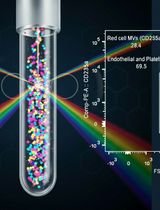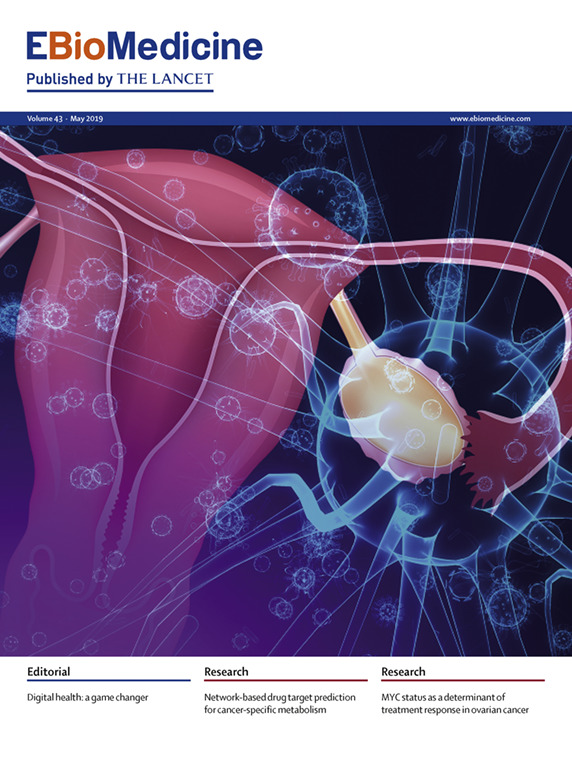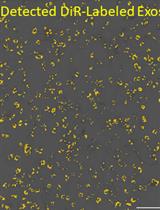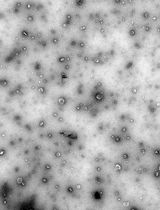- EN - English
- CN - 中文
Rapid Nickel-based Isolation of Extracellular Vesicles from Different Biological Fluids
从不同的生物体液中进行胞外囊泡的快速镍基分离
发布: 2020年02月05日第10卷第3期 DOI: 10.21769/BioProtoc.3512 浏览次数: 6759
评审: Alba Blesasujan kumar mondalilgen MenderAnonymous reviewer(s)

相关实验方案

外周血中细胞外囊泡的分离与分析方法:红细胞、内皮细胞及血小板来源的细胞外囊泡
Bhawani Yasassri Alvitigala [...] Lallindra Viranjan Gooneratne
2025年11月05日 1335 阅读
Abstract
Extracellular vesicles (EVs) are membranous structures that cells massively release in extracellular fluids. EVs are cargo of cellular components such as lipids, proteins, and nucleic acids that can work as a formidable source in liquid biopsy studies searching for disease biomarkers. We recently demonstrated that nickel-based isolation (NBI) is a valuable method for fast, efficient, and easy recovery of heterogeneous EVs from biological fluids. NBI exploits nickel cations to capture negatively charged vesicles. Then, a mix of balanced chelating agents elutes EVs while preserving their integrity and stability in solution. Here, we describe steps and quality controls to functionalize a matrix of agarose beads, obtain an efficient elution of EVs, and extract nucleic acids carried by them. We demonstrate the versatility of NBI method in isolating EVs from media of primary mouse astrocytes, from human blood, urine, and saliva processed in parallel, as well as outer membrane vesicles (OMVs) from cultured Gram-negative bacteria.
Keywords: Extracellular vesicles (胞外囊泡)Background
Extracellular vesicles (EVs) are heterogeneous membranous structures that cells release in the extracellular fluids. Besides the generation of apoptotic bodies, we now recognize at least two mechanisms that generate EVs, comprising the formation of multivesicular bodies (MVBs) in mature endosomes that fuse with the plasma membrane and discharge exosomes, and the direct release of membrane-budding vesicles known as microvesicles or ectosomes (van Niel et al., 2018). EVs are increasingly referred to as intercellular communicators which are able to influence the metabolism of recipient cells through the horizontal exchange of different components such as lipids, proteins, and nucleic acids (Raposo and Stoorvogel, 2013; Hirshman et al., 2016; Jeppesen et al., 2019). Besides the research efforts aiming to convert EVs into novel carriers of therapeutics, the incredible density and heterogeneity of EVs present in biological fluids hold promise for the interception of pathological conditions such as cancer or neurodegenerative diseases (Schiera et al., 2015; Bandu et al., 2019; Latifkar et al., 2019). Especially in cancer, this perspective is nowadays expanding the field of liquid biopsy tests, where the non-invasive detection of biomarkers through a systematic screening of circulating tumor cells, cell-free DNA, and EVs could advance early detection and monitoring, with novel opportunities for patients’ stratification and prediction of disease progression.
EVs have been detected in blood, urine, cerebrospinal fluid, saliva, tears, breast milk, as well as from cell culture media (Lässer et al., 2011; Rolfo et al., 2014; Salih et al., 2014; Pieragostino et al., 2019; Palviainen et al., 2019). Multiple strategies have been presented to isolate them, with protocols based on differential ultracentrifugation, density gradient, or polymer precipitation, allowing for a massive enrichment of dimensionally heterogeneous vesicles depending on their size, buoyant density, or lipid structure (Chen et al., 2019). Alternatively, immunocapture approaches have been exploited to enrich for EV sub-populations, virtually deriving from the same tissue of origin (Kowal et al., 2016).
In research laboratories, the most widely used method for EV isolation is the differential ultracentrifugation, in which large EVs of about 200-1,000 nm sediment at low speed (10,000 x g), while small EVs of about 50-200 nm pellet at high speed (100,000 x g), as described by Théry et al., 2006. This size-based classification cannot be exploited to infer the intracellular pathways of their biogenesis, as ectosomes generated by the outward budding of the plasma membrane can overlap in size with exosomes derived from the MVBs (multivesicular bodies). Nevertheless, specific tetraspanins (CD9, CD81, CD63) or lumen proteins (Alix, synthenin) are found to be enriched in the small EVs, including exosomes (Jeppesen et al., 2019; Latifkar et al., 2019). Ultracentrifugation has some drawbacks related to reproducibility of results when comparing different instruments/rotors, or to the physical force applied to balance yield versus integrity (Livshits et al., 2015). Typically, this technique is combined with size-exclusion chromatography or floatation in Optiprep gradient to separate EVs from co-sedimenting protein aggregates (Théry et al., 2018). However, these approaches are inapplicable in view of a routine clinical practice, where the recovery of EVs needs to be fast and the biological sample not exposed to chemicals that could contribute experimental variability but interfere in downstream analysis. For these reasons, other microfluidic- or electromagnetic-based technologies that exploit other biophysical features of EVs have been implemented (Hou et al., 2019). The strategy of capturing EVs through electrostatic interactions (negative zeta potential values) has recently shown the advantages of rapidity and versatility in terms of device implementation, combination with other protocols like size-exclusion chromatography, and recovery of heterogeneous suspended vesicles (Petersen et al., 2018; Heath et al., 2018).
Here, we describe the procedure of nickel-based isolation (NBI) we recently developed as a low-cost and convenient method for isolating EVs (Notarangelo et al., 2019). This method is based on nickel cations to capture EVs and on the use of chelating agents that synergistically elute vesicles in a physiological pH (or pH-controlled) solution. We demonstrated that NBI efficiently captures EVs and isolates them as non-aggregated vesicles in solution while preserving their integrity and minimizing the co-elution of exogenous protein contaminants (Notarangelo et al., 2019). Importantly, NBI method is fast, scalable, and easy to apply, offering a valuable option for liquid biopsy investigations and EV preparations that could benefit from increased stability and a non-aggregated distribution in solution. We describe the procedure starting from the functionalization of a matrix of agarose beads with nickel ions, the steps for efficient elution, and the protocol we use to extract nucleic acids from eluted EVs. We show here the versatility of NBI method in isolating EVs from different biological fluids, including media from primary mouse astrocytes, human plasma, urine, and saliva processed in parallel, as well as outer membrane vesicles (OMVs) from cultured Gram-negative bacteria.
Materials and Reagents
- Low-binding protein tubes: LoBind Tubes, Protein LoBind, 2.0 ml, PCR clean (Eppendorf, catalog number: 0030108132)
- Ni Sepharose® High Performance, pack of 25 ml (GE Healthcare, catalog number: 17-5268-01), store at 4 °C
- PVDF Syringe Filters (Euroclone, Primo® Syringe Filters, 0.22 μm pour size, catalog number: EPSPV2230)
- 50 ml tube
- 15 ml Falcon tube
- 1.5 ml centrifuge tube
- Water prepared by ultrafiltration, reverse osmosis, deionization and sterile filtration (e.g., Lonza®, catalog number: 17-724Q)
- Phosphate-buffered saline (PBS 1x, pH 7.4) (Thermo Fisher®, catalog number: 10010023)
- Nickel sulphate powder, NiSO4 (Sigma®, catalog number: 656895)
- NaCl powder (Sigma®, catalog number: 450006)
- EDTA [0.5] M (Thermo Fisher®, UltraPure pH 8.0, catalog number: 15575020)
- Citric acid (Sigma®, catalog number: 251275)
- TRIzolTM Reagent (Thermo Fisher®, catalog number: 15596026)
- Agilent RNA 6000 Pico Kit (Agilent, catalog number: 5067-1513)
- Chloroform (Sigma®, catalog number: C7559)
- Isopropanol Molecular Biology Reagent (Sigma®, catalog number: I9516)
- Ethanol (Sigma®, catalog number: 51976)
- UltraPureTM DNase/RNase-Free Distilled Water (Thermo Fisher®, catalog number: 10977035)
- Glycogen, RNA grade (Thermo Fisher®, catalog number: R0551)
- Buffer S (Stripping buffer) (see Recipe 1)
- Buffer N (see Recipe 2)
- Solution A 5x (see Recipe 3)
- Solution B 5x (see Recipe 4)
Equipment
- Laminar flow hood
- Burker chamber (VWR, MARI0640230)
- Eppendorf® Centrifuge 5702, non-refrigerated, with Swing-bucket Rotor (A-4-38) included adapters for 15/50 ml conical tubes (Eppendorf, catalog number: 5702 000.32) (used in paragraphs A-B-C of the procedure)
- Eppendorf® Thermomixer Comfort (Eppendorf, catalog number: 5355.000.011)
- VWR® Tube Rotator (VWR, catalog number: 10136-084) with interchangeable rotisserie assembly for: 10x 10/15 and 16x 5/7 ml tubes (VWR, catalog number: 444-0504), 6x 50 ml tubes (VWR, catalog number: 444-0505), 36x 1.5/2.0 ml tubes (VWR, catalog number: 444-0503)
- Eppendorf® Centrifuge 5415 R (Eppendorf, model: Centrifuge 5415 R, catalog number: 22 62 140-8), refrigerated, with Rotor (Eppendorf, catalog number: F-45-24-11) (used in Procedure D)
- 2100 Bioanalyzer Instrument (Agilent Technologies, catalog number: G2939BA)
- -80 °C freezer
Procedure
文章信息
版权信息
© 2020 The Authors; exclusive licensee Bio-protocol LLC.
如何引用
Notarangelo, M., Ferrara, D., Potrich, C., Lunelli, L., Vanzetti, L., Provenzani, A., Basso, M., Quattrone, A. and D'Agostino, V. G. (2020). Rapid Nickel-based Isolation of Extracellular Vesicles from Different Biological Fluids. Bio-protocol 10(3): e3512. DOI: 10.21769/BioProtoc.3512.
分类
细胞生物学 > 细胞器分离 > 胞外囊泡
癌症生物学 > 基因组不稳定性及突变 > 肿瘤微环境
您对这篇实验方法有问题吗?
在此处发布您的问题,我们将邀请本文作者来回答。同时,我们会将您的问题发布到Bio-protocol Exchange,以便寻求社区成员的帮助。
Share
Bluesky
X
Copy link











